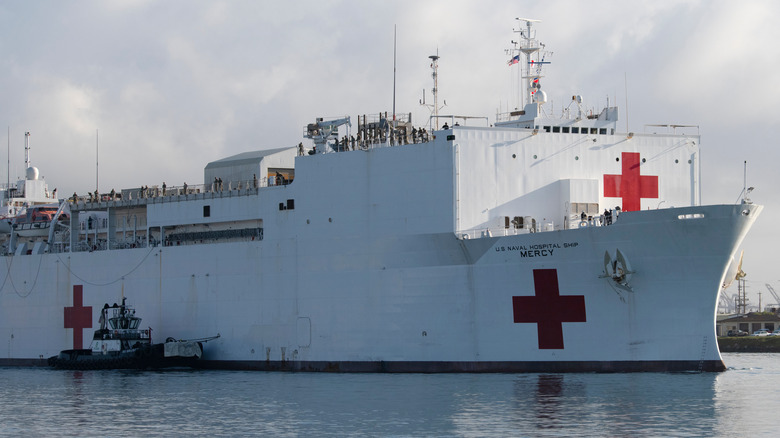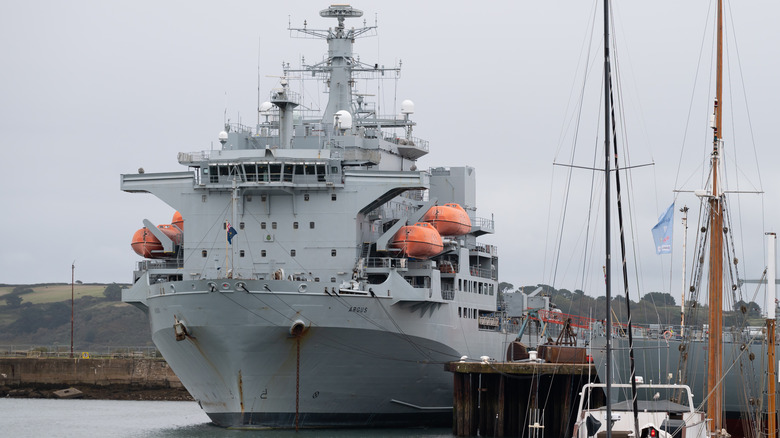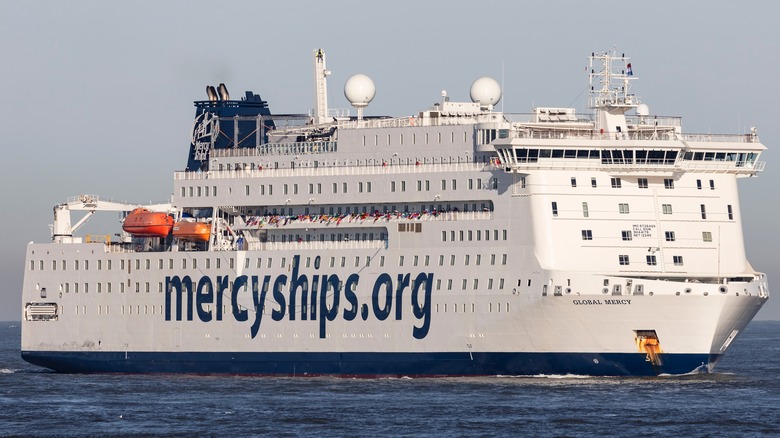What Are Hospital Ships And What Makes Them So Special?
The land masses we call home only make up about one-third of the surface of the Earth. This leaves an enormous amount of water, on which we travel in small yachts for fun, vacation on cruise ships — as distinct from ocean liners – for pleasure, and use fishing boats for food. Then there are naval vessels, from the smallest patrol boats to the biggest aircraft carriers in the world. Military action often means casualties, which highlights a crucial, unique type of ship often employed by navies: the hospital ship.
Just as a cruise ship is often referred to as a floating city, a hospital ship is designed as just that: a hospital on the water's surface. Such a hospital has the advantage of being mobile, administering aid and treatment, or reaching those in need of its services, where transport would otherwise be a great logistical challenge — if not impossible. A hospital ship is the waterborne equivalent of an air ambulance, dramatically increasing the scope of medical professionals' ability to treat patients.
The critical aspect of a hospital ship is that sometimes it must cater to more advanced medical needs. RFA Argus, for instance, is described by the United Kingdom's Royal Navy as "A Casualty Receiving Ship with a fully equipped hospital," boasting an operating theater and sophisticated scanning equipment. This is the thing about the biggest hospital ships. They aren't simply ships offering medical experts, supplies, and treatments — they can truly be mobile hospitals on the oceans.
Military hospital ships
Hospital ships are often military vessels. RFA Argus, for example, is an imposing sight, at over 574 feet long and displacing 30,954 tons. It began life as a transport vessel before joining British service during the Falklands War, and though it now serves in a medical capacity, it's far from undefended — in fact, its arsenal includes Oerlikon KAA200 cannons. Being equipped with such weapons means that under the Geneva Convention, it doesn't technically qualify as a hospital ship. It's the only vessel of its kind in the Royal Navy, so the force both has a Casualty-class hospital ship and doesn't.
The United States Navy has two hospital ships, USNS Mercy and USNS Comfort, which entered service in 1986 and 1987, respectively. Similarly to the British vessel, both formerly fulfilled very different purposes – Mercy was originally an oil tanker and Comfort a supertanker. At 894 feet long, these are some of the largest ships in the U.S. arsenal. And some of the services and facilities they can fit into their sizable frames are truly remarkable.
They each have 15 wards holding 1,000 beds, as well as 12 operating rooms and a pharmacy. They can even accommodate a helicopter on deck, so patients can arrive by land, air, or sea. Though the Navy is seeking to build a faster, smaller Expeditionary Medical Ship to join them by 2028, in the shape of the USNS Bethesda, these are truly impressive, advanced vessels.
Other hospital ships
Hospital ships are not necessarily naval vessels. The charity Mercy Ships operates two hospital ships, Global Mercy and Africa Mercy. Global Mercy, at 571 feet long, demonstrates what a hospital ship can offer beyond the medical sphere. With amenities from a library to a 682-seat auditorium, it's a fully featured vessel that still focuses on treating those who need it. Mercy Ships says it can perform "maxillofacial and plastic-reconstructive surgery to address tumor removal and debilitating burn contractures, cleft lip and palate repair, orthopedics, cataract removal, and obstetric fistula repair."
Mercy Ships began operating in 1978, using hospital ships to deliver treatment to areas of the world most in need. Its founders, husband and wife Don and Deyon Stephens, utilize volunteer medics and crew to provide the charity's services. Africa Mercy is currently in Toamasina, Madagascar, at the heart of an effort to provide over 2,850 procedures by the end of 2025.
Historically, hospital ships have had great value at times of conflict, such as the Union Steam Ship Company's SS Marana and SS Maheno, passenger ships that both became New Zealand hospital ships in 1915, during World War I. For military or civilian purposes, whether floating hospitals in their own right or in the form of medical facilities on larger vessels — there are 41 hospital beds in the aircraft carrier USS Gerald Ford – these ships represent one more way the medical experts who save lives around the world tend to their patients.


